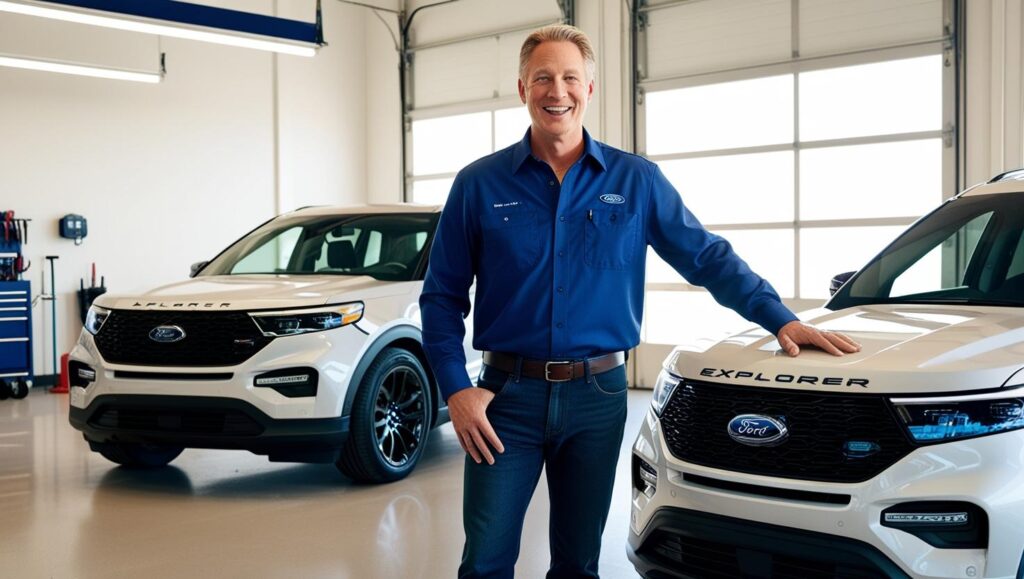In this article, we discuss What Is Ford Replacing The Ford Edge With. The Ford Edge has been a popular choice in the mid-size SUV market for years, known for its sleek design, ample cargo space, and tech-friendly features.
However, with the evolving trends in the automobile industry and shifting customer preferences, Ford has decided to discontinue the Edge and introduce a new model as part of its strategic shift. This article explores what Ford is replacing the Ford Edge with, the reasons behind the transition, and how this change reflects Ford’s future direction in the SUV segment.
We’ll dive into real-world examples of similar product transitions in the auto industry, look at consumer reception, and assess the potential impact of Ford’s strategy on its market share.
What Is Ford Replacing the Ford Edge With?
Ford is replacing the Edge with the Ford Evo in several international markets and the Ford Explorer EV for North American customers. This decision reflects the company’s renewed focus on electric vehicles (EVs) and crossover SUVs, aligning with the broader industry push towards electrification and sustainability.

Initially launched in China, the Evos blends SUV practicality with coupe styling, aiming to attract a tech-savvy, modern audience. The Explorer EV, part of Ford’s bold commitment to introducing more electric models by 2025, is a flagship electric SUV for North America.
Why Is Ford Phasing Out the Edge?
There are several strategic reasons behind the decision to replace the Edge:
- Shift Towards Electric Vehicles: Automakers across the globe are investing heavily in electric vehicles to meet stricter emission regulations and cater to environmentally conscious consumers. Ford is no exception, targeting 40% of its global sales to be electric by 2030. Being a traditional gas-powered SUV, the Edge no longer aligns with this eco-focused strategy.
- Declining Sales and Market Trends: Mid-size SUVs like the Edge have faced stiff competition from newer crossovers and hybrid models in recent years.
According to Ford’s 2023 sales data, the Edge experienced a 15% decline in sales, reflecting the changing preferences of SUV buyers. Consumers today prefer vehicles that offer a blend of luxury, performance, and sustainability—something Ford aims to achieve with the Explorer EV. - Product Overlap and Portfolio Optimization: Ford’s decision to phase out the Edge also reflects the need to streamline its product lineup.
With several SUVs already available, including the Bronco Sport, Escape, and Explorer, the Edge began to overlap with other models, creating customer confusion. Ford now focuses on offering fewer but more distinct vehicles.
What Is Ford Replacing The Ford Edge With Ford Evos and Explorer EV
- Ford Evos – A Fusion of SUV and Coupe: The Ford Evos was initially launched in China, but rumors suggest it may arrive in North America soon. This model represents Ford’s innovative design direction with:
- Hybrid powertrain options for reduced emissions.
- A sizeable 27-inch infotainment display is targeting tech-savvy drivers.
- A coupe-style exterior blended with SUV practicality.
While the Evos has yet to hit American shores officially, Ford is hinting at using similar design cues across its future crossover models.
Explorer EV – The Future of Ford SUVs
The Explorer EV will be Ford’s next flagship electric SUV for North America. Unlike the Edge, the Explorer EV offers:
- Up to 300 miles of range on a single charge.
- Compatibility with Ford’s BlueCruise hands-free driving system.
- Fast-charging capability, making it suitable for road trips.
Ford has already launched the Mustang Mach-E successfully, and the Explorer EV is expected to follow in its footsteps. The Mach-E’s success is a testament to Ford’s ability to innovate and adapt to changing market trends. With the Explorer EV, Ford is replacing the Edge and strengthening its foothold in the electric SUV market, offering a vehicle that combines luxury, performance, and sustainability.
Consumer Reception and Market Impact
Ford’s strategic shift has generated mixed reactions and garnered significant positive feedback. Early reception from Chinese customers about the Evos has been overwhelmingly positive, with many praising its futuristic design and tech features.
Similarly, Ford’s commitment to expanding its EV lineup has been well-received, particularly in markets like California, where EV adoption is high. This positive reception reassures us that Ford’s strategic shift is not just a change but a step towards a more sustainable and consumer-friendly future.
Additionally, analysts predict that the Explorer EV will become a strong competitor to the Tesla Model Y and Volkswagen ID.4, helping Ford capture a larger share of the growing electric SUV market. This strategic shift, combined with Ford’s commitment to sustainability and innovation, is expected to enhance its market share and strengthen its position in the competitive SUV segment.
Lessons from Other Auto Manufacturers
Ford’s strategy of replacing the Edge mirrors similar moves by other car makers:
- General Motors replaced the gas-powered Chevy Malibu with the all-electric Chevy Blazer EV to align with its electrification goals.
- Volkswagen discontinued the Passat sedan to focus on SUVs and electric models like the ID.4.
These transitions highlight how automakers are future-proofing their portfolios by introducing EVs and more sustainable models to meet consumer demand. Ford’s move with the Explorer EV and Evos positions it well for this shift, offering both luxury and sustainability in one package.
Know More:
FAQs
What is replacing the Ford Edge?
Ford is replacing the Edge with the Ford Evos in international markets and the Ford Explorer EV in North America.
Why did Ford discontinue the Edge?
Ford discontinued the Edge to focus on electric vehicles and streamline its SUV lineup, ensuring its models align with future market trends and environmental regulations.
Will the Ford Evos be available in the U.S.?
While the Evos is available in China, Ford has suggested introducing similar crossover designs in North America.
When will the Ford Explorer EV be released?
The Explorer EV is expected to launch by mid-2025, joining Ford’s expanding lineup of electric SUVs.
Ford’s decision to replace the Ford Edge with the Evos and Explorer EV reflects the company’s commitment to innovation, sustainability, and market relevance. Automakers must adapt to stay ahead as the automobile industry shifts towards electric vehicles.
With the Explorer EV’s promising features and the Evos’ unique design, Ford aims to capture the evolving preferences of modern consumers.
By streamlining its portfolio and embracing electrification, Ford is setting itself up for long-term success in the competitive SUV segment. This transition ensures Ford stays relevant and reflects broader trends shaping the future of the automotive world.
This case study demonstrates how automakers, including Ford, are evolving in response to market shifts and technological advancements. The move from the Ford Edge to new electric models highlights the importance of innovation and customer-centric strategies in today’s dynamic auto industry.
